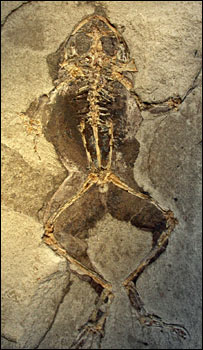Soft tissue found in frog fossils
 Specimens are found in Spain. (Photo: BBC) Scientists have isolated the bone marrow of frogs and salamanders who died 10 million years ago in peat bogs of northeastern Spain.
Specimens are found in Spain. (Photo: BBC) Scientists have isolated the bone marrow of frogs and salamanders who died 10 million years ago in peat bogs of northeastern Spain.
The first fossil bone marrow that this science has brought a rare message about the physiological characteristics of prehistoric animals.
Until now, usually only hard tissue like bone is left in fossil samples, soft tissue is often decomposed and dissipated over a long period of time.
The newly discovered bone marrow is preserved in a three-dimensional condition, still in its original structure and red in yellow.
"Finding soft tissue like this is important because it provides information about the physiological properties of ancient organisms, as well as their mechanism of action," said Maria McNamara , team member. from Dublin University.
Frogs and salamanders are found in a fossil-rich sediment of the Middle Kingdom - a period stretching from 5.3 to 23 million years ago.
McNamara and colleagues believe that they will find more bone marrow, giving hope about the reproduction of proteins and even the DNA of prehistoric creatures.
T. An
- Dinosaurs have them with ... chickens?
- Finding fossils with extremely rare soft tissue
- Can soft tissue of dinosaurs really exist?
- New X-ray technology can see soft tissue
- Soft tissue lesions in children
- Discovered new tree frog species in the Central Highlands
- Find an endangered frog
- Artificial wombs help discover embryonic development secrets
- Detecting new frogs 'tiny', excessively placed on nails
- Oral tissue lesions in children
- Amazingly 2 5 thousand year-old frozen mummies are still intact in Canada
- Discover new stone frog in Cao Bang
 Discovered an ancient centipede fossil 99 million years old
Discovered an ancient centipede fossil 99 million years old Discovered bat-like dinosaurs in China
Discovered bat-like dinosaurs in China Discovered a 200-year-old bronze cannon of the coast
Discovered a 200-year-old bronze cannon of the coast Discover 305 million-year-old spider fossils
Discover 305 million-year-old spider fossils